Weaving Happiness Amidst Cultural and Religious Co-existence
Enter any weaving village and you will be welcomed by the pleasant clacketing of shuttles interspersed with muted chants of the holy mantra Buddham saranam gacchami, Dhammam saranam gacchami, Sangham saranam gacchami. To commemorate the auspicious occasion of National Handloom Day, Team My City Links visited two weaving villages of Cuttack district- Nuapatna and Maniabandha.
Destination
Maniabandha and Nuapatana are neighbouring villages in Tigiria and Badamba blocks of Cuttack district at a distance of 70 kms from Bhubaneswar. Both Maniabandha and Nuapatna and their surrounding villages are inhabited by a large number of weavers. The hamlets are famous for their rich weaving and Buddhist culture. With a booming population of more than 5000 souls, the entire village is both Buddhist and weavers with nearly 3000 looms plying the craft. Those interested in religious worship can also visit Bhattarika, 25 km away from Nuapatna on the serene Mahanadi.
Link to Lord Jagannath
The fame of the village spread far and wide after the immortal poet of Odisha, Jayadeva, presented his epic, Gita Govinda, to Lord Jagannath wrapped in a silk fabric during the 12th century AD. Weavers of this fabric wove the script of verses of Gita Govinda by using tie and dye technique. Jayadev wrapped his epic in it and offered it to the three deities at the Jagannath Temple. Till today, Gita Govinda verses are woven on silk and a special red-coloured Khandua cloth with verses from Gita Govinda is worn by Lord Jagannath at Puri Temple. The rathas (chariots) are also covered and decorated with this Khandua silk during Rath Yatra. The village and the craft have won universal recognition over the years. The weavers are deeply associated with the Jagannath culture.
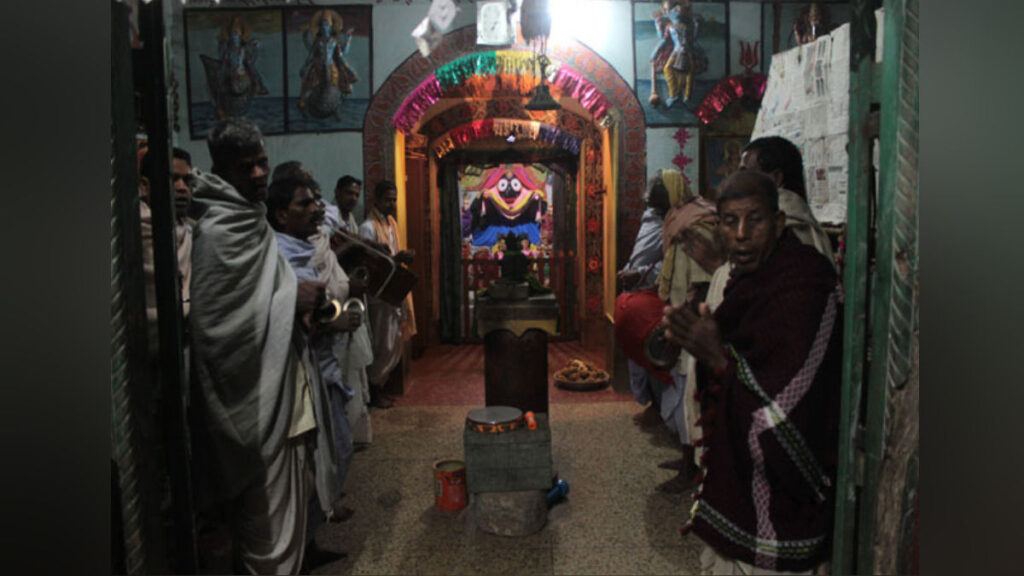
Special weavers of Nuapatna produce calligraphy on the fabrics with Gita Govinda and Dasavatar (ten reincarnations of Vishnu). During production of these fabrics for spiritual purpose, the weavers (males) strictly observe certain principles like fasting and not consuming non-vegetarian food. Design motifs include elephants surrounded by trailing vines with peacocks in it, petaled flowers and Nabagunjara, a mythical creature associated with Lord Jagannath.
Establishment of Buddhism
Buddhism is a religion that was propounded by Gautama Buddha in the middle of 1st millennium BCE, based on the principles of compassion and detachment. Maniabandha is probably the only place in India with near total traditional adherents of Buddhism. Although history is ignorant of the Buddha having set foot in the land of Odisha, his compassionate imprint is indelibly intertwined with the legacy of this soil. In the struggle for religious dominance, Buddhism lost out and was consigned to the margins with a lingering presence of limited followers of the faith in Odisha, predominantly with weaving as a way of life.
In the 16th century AD, a large group of Buddhist worshippers who knew the art of handloom weavers came from Bardhaman district of West Bengal to Badamba owing to regional and religious disturbances. As per historical narrative, they met the then Badamba king, presented some clothes woven by them and sought for shelter. Impressed by the artistic skills of the weavers, the king allowed them to halt at a distant place called Maniabandha despite the protest of Brahmins of his kingdom. They were also allowed to start their trade of weaving for the locals to cater to the clothing needs.
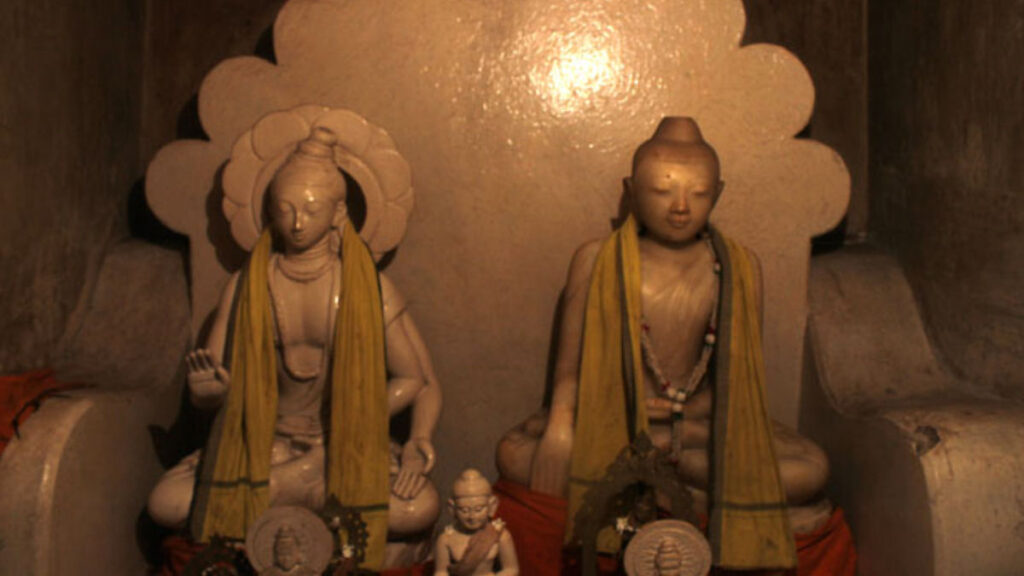
The community today has spread its habitation to other nearby villages at Nuapatna and keeps their traditional profession of weaving handloom products. But all these people have not forgotten their lord Gautama Buddha, and still follow His teachings.
The exterior of Buddhist places of worship resemble the Puri Jagannath temple. But inside, sculptures of the Buddha have the highest pride of place. Almost all households have colourful paintings of the Buddha- on their exteriors and interiors.
Non-violent weaving
Possibly the only traditional Buddhists left in India, the Maniabandha weavers are vegetarian in nature, practise prarthana and meditation every morning and evening and are very conservative on caste.
The non-violent philosophy of Buddhism extends to their craft also as the dwellers of Maniabandha are pure vegetarians. Contrary to the norm of boiling silkworms, the weavers extract ‘Eri’ thread from the cocoon shed by the worms. Therefore, Pata Khandua, stands as the best example of Samyak Ajiba– Right Profession- as preached by the Buddha.
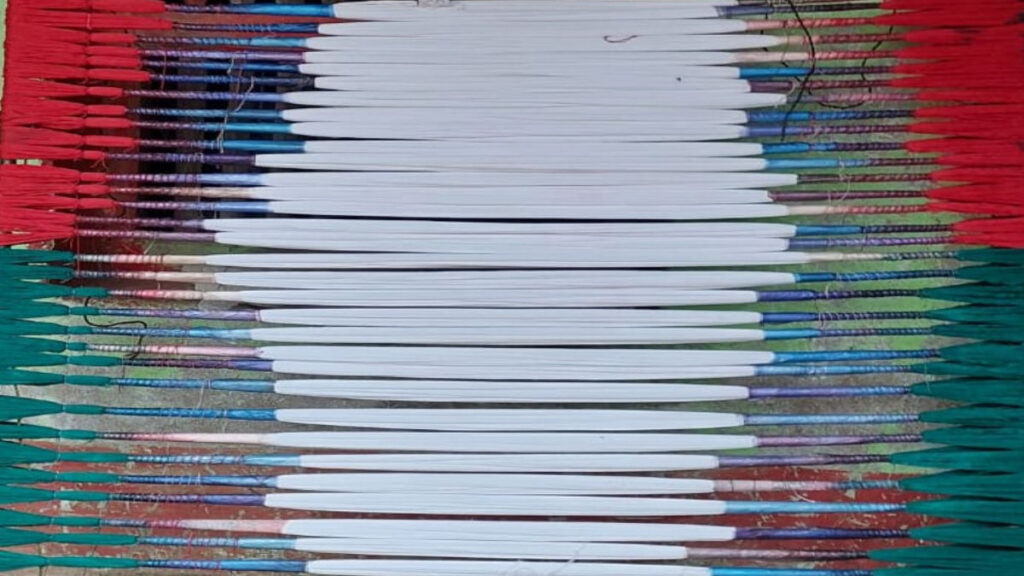
Akula Charan Nandi, a state-award winner, showed the sublime Buddha ‘sooktha’ he had woven as his eyes lit up with incandescent pride. “As weavers we do not kill any animal. If we plough the land, it is quite possible to destroy life. With weaving, we do not tell lies or cheat. We are all equals- no rich or poor. We are vegetarians and abstain from alcohol. Many of us avoid onion and garlic as they are considered tamasic food,” he said.
“It is a testimony to our unswerving commitment to non-violence. Even while following the path of Dhamma we continue to offer worship at the altar of Jagannath as well. This accommodation of the majoritarian creed in our belief system ensures the existence of compassion and empathy. All religions preach the same principles- to be kind and compassionate to one another,” added the state-award winning weaver.
These Buddhists are considered as weavers of the highest order. According to a legend, in the 7th Century CE, the Chinese scholar monk Huen TSang was offered a saree at Maniabandha, the village that linked the ports of Odisha to its hinterland. Packed in a hollow bamboo pipe, the saree was handed over to him. Huen TSang was visibly impressed with the wizardry of weaving and spread the word around.
Buddha Purnima
Over 15 Buddha temples have been found in the Maniabandha region where they follow the discourses of Buddha. A large structure related to their religion and culture called Boudha Vihar has been developed with the active assistance from the state government where a large hall and different rooms for displaying their products of handloom weaving has been set up over two acres of land where they perform their religion- based functions. These Buddhist worshippers observed Vaisakh Purnima as Buddha Jayanti with great fervour.
The ‘Buddha Purnima’ that falls in the April-May season witnesses the greatest celebration in the life of the tribe. Considering the importance of Maniabandha handloom products which have good name and fame worldwide, the then Tourism Minister of the State Debi Prasad Mishra had started a five-day long Buddha Mahotsav in Maniabandha since the year 2011. Since then, the Mahotsav is organised every year during the period of Buddha Purnima under the aegis of the State Culture Department, the Cuttack district administration and the local Buddhist Association. Over fifty stalls particularly on Maniabandha loom products open at the Mahotsav site for exhibition and sale.
Living in harmony
Today Maniabandha and Nuapatana are not only an important destination for textile lovers, but also for those having deep interest in understanding and appreciating the syncretic culture practised in the region. The weavers are also followers of Lord Jagannath and this is visible not only in the motifs on Khandua but also in the way they live and worship. Maniabandha is a perfect example of religious harmony between Hindus and Buddhists. They earnestly take part in each other’s festivals and religious gatherings. The yarns of livelihood and brotherhood bind them strongly just like the pure and divine Khandua Pata.
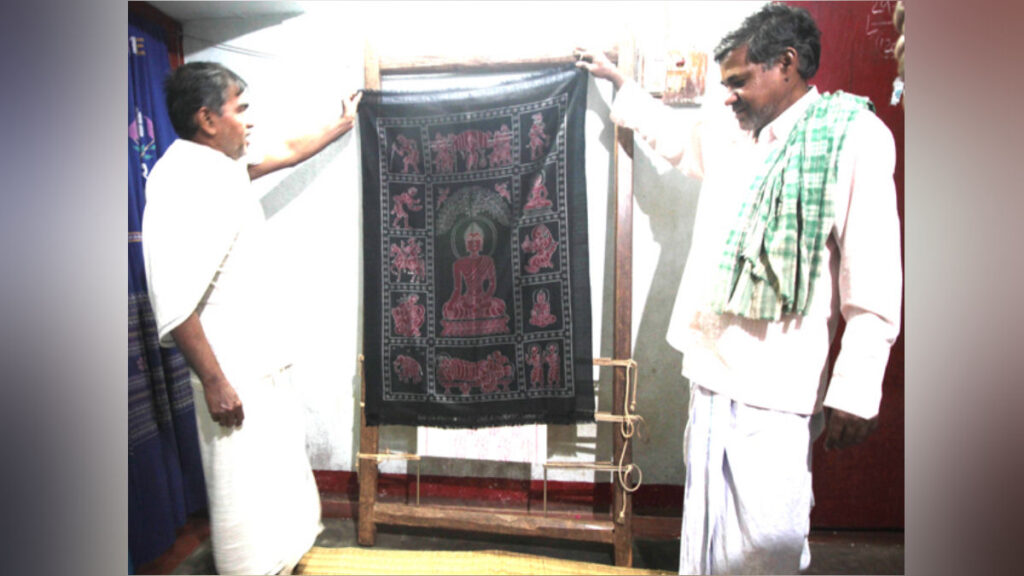
Each member of the family is involved in some aspect of weaving- dyeing the yarn, tying the loom, designing patterns, finishing the sari and so on. Learning the trade is part of their daily life. Women of all ages participate in the production. They take pride in their creative ability and display exquisite patterns. A loom in the entrance room is a common sight in every household.
The predominantly Buddhist weavers have learned to live side by side with their Hindu neighbours. In their weaving, saris are specially woven for the Hindu deities Lord Jagannath, Balabhadra and Subhadra by the artisans of Maniabandha and Nuapatna.
“This practice has continued for several hundred years. We also produce sarees for Goddess Lakshmi with nine motifs: lotus, elephant, temple, peacock, water pot, conch cell, butterfly, and deer. Hindu and Buddhist weavers not only celebrate each other’s festivals but also participate in each other’s ritual performances. Buddhist weavers of Maniabandha are aware of combining Hindu and Buddhist symbols. Buddhist symbols such as lions, swans, and lotuses, and orange and red colours, are visible on the Maniabandha saree. Hindu symbols such as temples, swans, lions, water pitchers and roses are woven alongside, making for an intricate pattern,” shared a local artisan of Maniabandha.
Assistance provided
The Weavers Service Centre, Bhubaneswar collaborated with the eminent fashion designer Ritu Kumar, at her request, for weaving warp Ikat yardage for high fashion garments. For this project, a camp was specially organised to train weavers in upgrading their design skills. After its successful completion, she, along with 4 other designers and technical staff, along with the Officer In-charge and Textile Designer of WSC, set up their work station at Nuapatna Weavers Cooperative Society for the production of her orders. Orders were received for designs like Bhasu, Bharga, Bharwa, Mahika and Mundi.
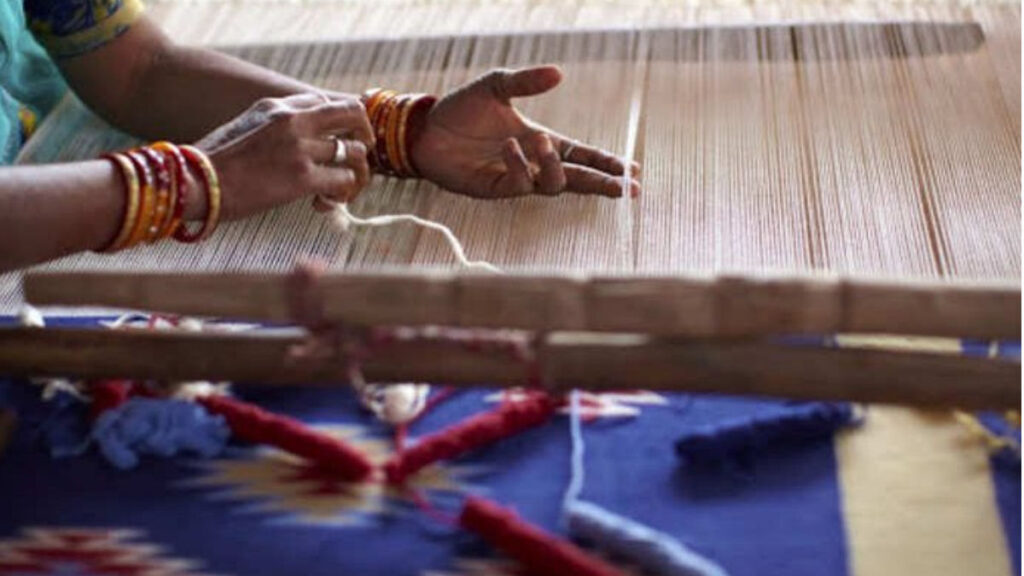
The Odisha Rural Development & Marketing Society (ORMAS) has joined hands with TATA Trust to ease the hardships faced by the weavers of Maniabandha in recent years. With an aim to infuse traditional touch of ‘Kataki ikkat’ with contemporary designs, ORMAS in collaboration with ‘Antaran’, an initiative of TATA Trust is working towards the development of handloom clusters.
The women weavers of Maniabandha in association with ORMAS have formulated producer groups and SHGs are involved in weaving Khandua sarees and dress materials through traditional techniques. Antaran, through its initiative of Charkha to Market (C2M) aims to prevent drifting away of weavers particularly the younger generation from the handloom sector, so the programme will focus on the development of micro-enterprises led by local weaver entrepreneurs and thereby eliminating the role of middlemen, the joint CEO of ORMAS, Bipin Rout said.
The National Institute of Fashion Technology (NIFT), Bhubaneswar, also organises training programmes on natural dyes and other modern facilities and techniques for handloom weavers. Weavers from various handloom clusters of the state like Nuapatana, Maniabandha, Gopalpur, Atta and Bhagamunda participate in the programme that aims to help the craftsmen in understanding the minute details of handloom.

Author: Aafreen Firdaus
Aafreen is a doting mother to several kitties and a doggo who loves to pamper everyone with delicious food. She is a free spirit and a wizard of words and she loves to tell beautiful stories through her writing. She is also a loving and caring soul, always ready to pitch in with a helping hand and a smile on her face.
Read more from author


